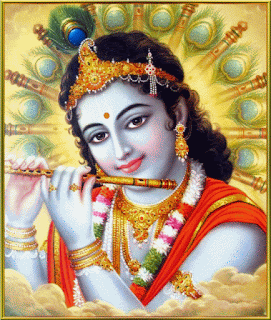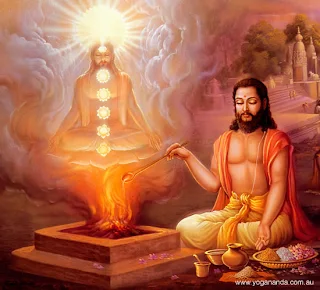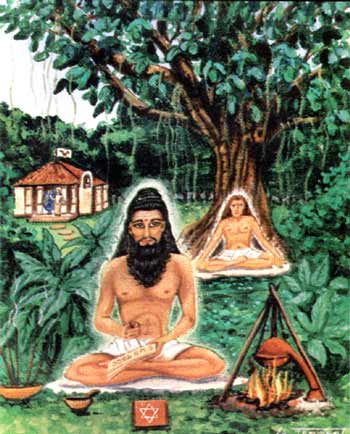uddhared ãtmanã ' tmãnam
nã 'tmanam avasãdayet
ãtmai 'va hy ãtmano bandhur
ãtmai 'va ripur ãtmanah
With the aid of your Self ( soul consciousness), lift yourself up from delusion. Do not degrade yourself, for you are your own friend, and you are your own enemy.(06:05)
Com a ajuda de seu Self (consciência da alma), saia da ilusão. Não se rebaixe, você é seu próprio amigo, e você é seu próprio inimigo (06:05).
TRUTH - THE GENUINE RELIGION
VERDADE - A RELIGIÃO GENUÍNA
All people are shallow in their understanding of Truth because they are taught that religious play is genuine religion. They don't know that they must meditate to reach that Truth, to reach the Self. External worship without sincere desire to unite with God and without meditation is a form of sense gratification and in itself actually masks the Self with illusion, delusion and error. In this way, external rites and rituals are a show, a play, and lead us farther away from the Self. Genuine religion means to unite with God, Who is the Self.
Todas as pessoas são superficiais na sua compreensão da Verdade, porque elas são ensinadas que a encenação religiosa é a religião verdadeira. Eles não sabem que têm de meditar para atingir essa Verdade, para atingir o Self. Externas adorações sem o sincero desejo de unir-se com Deus e sem a meditação é uma forma de gratificação dos sentidos e em si mesmo, na verdade encobre o Self com ilusão, ilusão e erro. Desta forma, os ritos e rituais externos são um espectáculo, um jogo, e nos levam mais longe do Self. A religião genuína significa unir-se com Deus, que é o Self.
"Since He is the Ear of the ear, the Mind of the mind, the Speech of speech, the Life of life, and the Eye of the eye, therefore the intelligent man after giving up self -identification with the senses and renouncing this world, becomes immortal."
"Brahman is really known when it is known as the Self of each state of consciousness, because thereby one gets immortality. Since through one's own self is acquired strength therefore thorough knowledge is attained immortality." The Kena Upanishad 1/2 and 2/4
"Desde que Ele é o ouvido do ouvido, a Mente da mente, o discurso da fala, a Vida da vida, eo Olho do olho, pois o homem inteligente depois de desistir de auto-identificação com os sentidos e renunciar a esse mundo , torna-se imortal. " 1/2
"Brahman é realmente conhecido quando ele é conhecido como o Self de cada estado de consciência, porque assim se obtém a imortalidade. Desde que é uma força de si mesmo , portanto, adquire-se um profundo conhecimento e é alcançada a imortalidade." A Kena Upanishad 2/4
Therefore, Brahman, Truth, cannot be perceived by the 5 sense organs, 12 pairs of cranial nerves, and 24 gross elements or by speaking highly of it. Nor can Brahman be reached by ceremonies or philosophical speculation, suggestion or imagination. Wisdom can be perceived by the atom only. The truly intelligent person is one who sincerely desires self-realization and meditates to achieve this supreme goal. To become self-realized, to understand the all-pervasive Self, to know that, requires humbly approaching a genuine spiritual master, asking him questions to clarify your understanding and have him impart his divine knowledge, infuse you with divine energy and guide you in meditation.
Portanto, Brahman, a Verdade, não pode ser percebido pelos cinco órgãos dos sentidos, 12 pares de nervos cranianos, e 24 elementos grosseiros ou falando muito dele. Também não pode ser alcançado pelas cerimônias a Brahman ou especulação filosófica, sugestão ou imaginação. A sabedoria pode ser percebida pelo único átomo. A pessoa verdadeiramente inteligente é aquele que deseja sinceramente a auto-realização e medita para atingir esse objetivo supremo. Para se tornar auto-realizado, para se compreender que tudo permeia, para saber que, requer humildemente se aproxima de um mestre espiritual genuíno, fazendo-lhe perguntas para esclarecer o seu entendimento e tê-lo transmitir o seu conhecimento divino, infundi-lo com a energia divina e orientá-lo na meditação.
Then you must apply this meditation in your daily life. Watch Him, in your every movement, thought, work, and disposition. You will learn to objectively separate your personality, or ego, from your true Self. You will see that God is the doer in every thought.
Então você deve aplicar essa meditação em sua vida diária. Observá-lo ( Deus) , em todos os seus movimentos, pensamentos , trabalho e disposição. Você vai aprender de forma objetiva separar sua personalidade, ou ego, de seu verdadeiro eu. Você vai ver que Deus é o fazedor, em cada pensamento.
Our life is meant for self-realization, for knowing the Self.
Nossa vida é destinada a auto-realização, para conhecer o Self.
Stitha Prajna - Julho de 2010
Stitha Prajna - July, 2010
I bow down to Shri Gurudev!


















.jpg)





.jpg)








![[113810-Nanda-Devi-0.jpg]](https://blogger.googleusercontent.com/img/b/R29vZ2xl/AVvXsEjQZznDzrWk0WIl5wjDgAop48fHB2V9PeSe1wJICo1uOClYEuhcvjd6KjzxXvNC1ppE3ywmwpH7kDs3HeBOju3GHViUtkvLRovcPwAL2zRcE8GtzbNp5F9u_2RWS_LR-6xtEXUV8-0ilOA/s320-rw/113810-Nanda-Devi-0.jpg)





